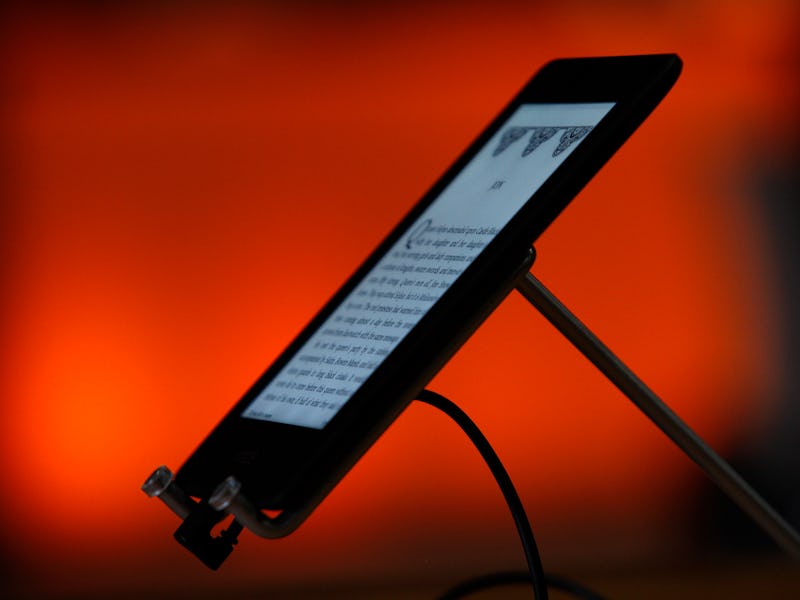Fans to Amazon: Either Leave "Perfect" Kindle Alone or Make It an iPad
Amazon is expected to reveal a new model next week, but it's not clear where the reader goes from here.

Amazon CEO Jeff Bezos sent bookworms into a flurry on Monday when he revealed the company will unveil a new Kindle next week. The model will be the eighth generation of the popular e-reader, but at this point, its hard to see where the 9-year-old gadget goes next. Kindle fans, for their part, seem a bit polar on the topic of changing the Kindle.
“[I’d like] more tablet-like functionality but with e-ink,” KBoards member J T. told Inverse. “I have a [Kindle] Voyage and at this point, the device is effectively perfect for my needs,” said member Speaker-To-Animals.
Kindle users congregate on sites like KUForum and KBoards. Much like the Kindle line itself, the sites contain little speculation about the future, instead focusing on good books to read or troubleshooting.
Most tech forums contain wishlists that last thousands of pages. Kindle forums seem to be a mix of readers and authors, quietly enjoying their books. The Kindle fanbase is almost a demonstration of what tech sites would be like if everything was fine.
Nonetheless, it turns out that, when asked, people on the forums do have strong opinions to give on where the Kindle could go. George Hamilton, a user on the KUForum, told Inverse that he would be persuaded by features that made it more like an iPad. “If I was to upgrade, I would be looking for an all-purpose touch pad type device which would provide a good internet as well as reading experience,” he said. “Probably with some other basic computing functions also.”
“I’d like a better browser, Chrome would be nice,” KBoards member KayakerNC echoed.
Since its inception, the Kindle has had one key task: display digital books on an easy-to-read screen. The Kindle first launched in 2007 for $399. It sold out almost instantly. It had a six-inch e-ink screen, storage for books, and a headphone jack for listening to audiobooks. Unlike traditional screens, the e-ink screen looks just like a page of paper, and only uses power when the screen contents change.
The first Kindle also introduced a revolutionary feature called Whispernet. It gave users access to a mobile service for free to download Amazon e-books from anywhere. Whispernet is still available anywhere cell phones work today.
The problem with the Kindle, essentially, is that it already does what it’s meant to. It reads books, and it reads them really well. The newest Kindle, an upgrade to the “Paperwhite” range that boasts ultra-white pages, ups the resolution to 300 dots per inch (dpi). Words are clearer than ever before.
Amazon also makes a $199 premium Kindle called the Voyage, with a glass screen and sleek design. But who reads a real book and complains that the experience isn’t premium enough, or the pages are too yellow? Most of the time, the book-reading experience is about what’s on the page.
Amazon already has an iPad-like device. It’s called the Kindle Fire and it’s not as good as the best iPad-like device: the iPad. So if you’re going to go that direction, iPad is the answer.
Of course, unlike a Kindle, the iPad has an LCD screen that doesn’t work as well in sunlight. Some also say that Kindle’s e-ink is easier on the eyes for long reading sessions. The iPad also uses a lot of power: Apple rates the 9.7-inch iPad Pro as having around 10 hours battery life during use. Amazon says the Kindle lasts around six weeks per charge, assuming half an hour of reading per day.
At the same time, the iPad’s screen is bright, vibrant, capable of displaying millions of colors with gorgeous video playback. The Kindle has a black-and-white screen with none of the technical prowess of the iPad’s screen, but that’s okay, as it doesn’t do half the things an iPad can do. It has been designed to do one job, and one job well: stepping beyond that feature set would be bold, but for what benefit? (Other than the fact that you would have an iPad – which you could have today after one quick trip to the Apple Store.)
The problem is, other than bringing on board more tablet features, there’s no easy answer to what the Kindle should do next.
Those satisfied with the Kindle’s feature set as it stands struggled to come up with big changes. “I can’t really think of anything I’m really hoping for,” said KBoards member Speaker-To-Animals. “I have a Voyage and at this point, the device is effectively perfect for my needs. In fact, if the 300dpi PaperWhite had been out at the same time as the Voyage, I’d have gotten that and saved the money.”
Others who were otherwise happy with the feature set asked for minor improvements, like better page turn buttons, improvements to backlight quality, and a home button to access books easier.
Beyond minor tweaks, or a rethink of what a Kindle should be used for, it’s hard to see where the Kindle can go in the future. The other option is a radical redesign, but one that maintains the same core feature set. Twitter user a2bicycle tweeted at Bezos to share what a big overhaul could look like.
KBoards user quadtronix also had some big ideas for changes, like dual, color displays that fold together like a real book. Other wishes include a curved, bezel-less screen, thinner than ever before and with the ability to bend like real paper. “I’m completely serious when I say that I would like to see any or all of these new features,” they said.
Whatever the next Kindle ends up looking like, it’ll be interesting to see how Amazon tries to improve on perfect.